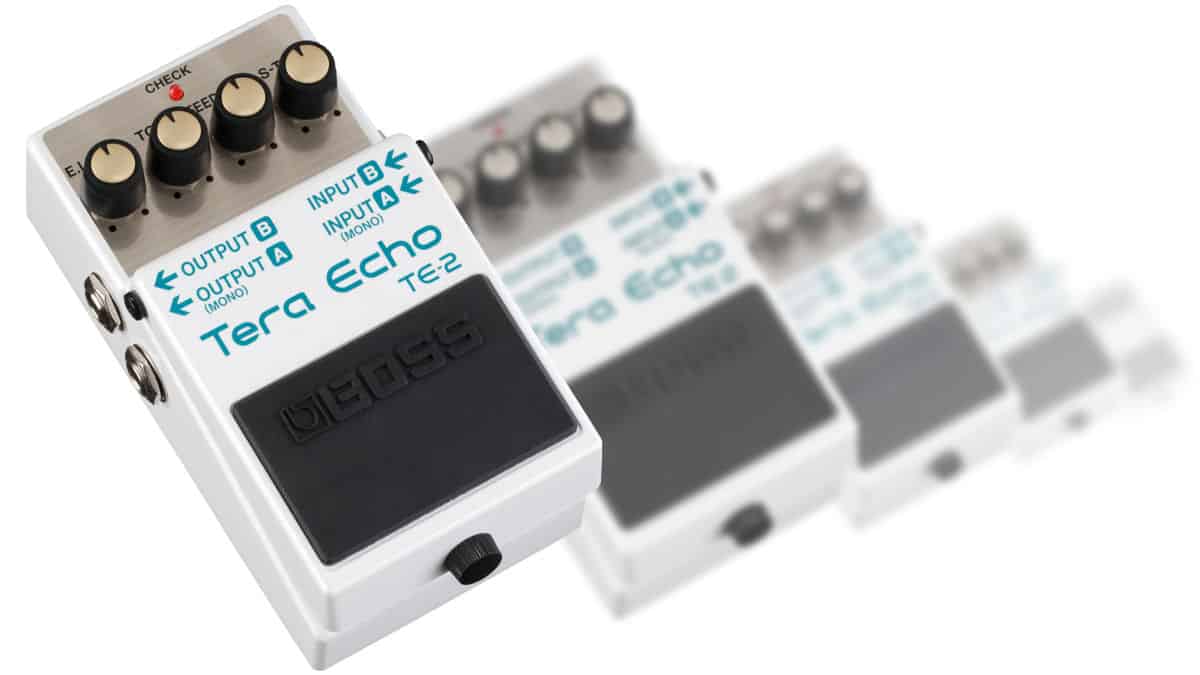Columns
Bat Utility Belt: Boss TE-2 Tera Echo

This misunderstood stompbox adds magic to synth pads.
When Boss released its 100th compact effects pedal in 2013, it tried something truly different. Unfortunately, guitarists around the world didn’t quite understand. The TE-2 Tera Echo combines reverb, filtered echoes, and a freeze function with a technology Boss calls Multi-Dimensional Processing (MDP). “Make your playing soar with majestic ambience,” proclaimed the brochure. But guitar players who simply plugged in, cranked the knobs, and strummed heard what sounded like gargling space lasers. The pedal quickly hit the second-hand market.
With some tweaks and the right patches, though, the Boss TE-2 adds magic to synthesizer sounds. That makes it an ideal entry in the Bat Utility Belt series, where I cover unexpectedly useful synth gadgets that cost around $100. (The TE-2 currently retails for $149.99, but is widely available used for $99.)
Que Tera Tera
Tera means temple in Japanese, but the TE-2’s echoes are more otherworldly. Play a percussive sound with the knobs straight up, and you’ll hear reverb and a cluster of panning, resonant echoes that drift farther apart as they decay. Unlike conventional delays, the TE-2 has no tap-tempo or simple duration control; rather, the S-Time (spread time) knob increases the spacing between the echoes in the cluster. In fact, there are so many little echoes that you don’t need to think about tempo; they just fill out the sound. Twisting the S-Time knob while audio is playing alters the pitch of the echoes, as on an analog delay. Turning it all the way down collapses the echoes into a slapback effect.
Looking left, the Feedback knob adjusts the time it takes the effect to fade out; it controls both echo and reverb. With S-Time all the way down and Feedback around 2 o’clock, you get a nice reverb with a subtle pulse of echo. There’s also a tiny zone around 4 o’clock where you can get infinite sustain and create massive layered textures. Turning the knob higher creates runaway feedback.
The Tone knob is an oddball. I think of it as the Space Laser knob, because if S-Time is turned up and you play a sound with a sharp attack (like plucking a guitar string), the result sounds like a horde of aliens firing their weapons. The echoes have a sproingy sound, like a resonant lowpass filter. I read a number of guitar-centric reviews that recommended keeping the Tone knob all the way down, but that’s where the Multi-Dimensional Processing comes in.
From what I can tell, MDP varies the effects based on the timbre, pitch, and dynamics of the input signal. Boss’s MDP Deep Dive offers more detail. The bottom line for synthesists is that sounds with long attacks (like strings and pads) enjoy the majestic Tera Echo ambience without the laser zaps. With these sounds, the Tone knob behaves as expected in the bottom half of its range, controlling the brightness of the echo and reverb. Cranking it past 12 o’clock adds a resonant edge to the effects.
The Cool Part
The TE-2 also has a hidden feature: holding down the footswitch activates a freeze mode, in which the pedal smoothly loops the sound that was passing through, complete with effects. The loop is about a second long and heavily crossfaded, so you’ll hear a texture or burble instead of a percussive loop. What’s cool is that you can continue to play on top of the frozen sound. The TE-2 processes the new audio with the current settings of the Tone, Feedback, and S-Time knobs, but doesn’t add it to the frozen loop, which makes it easy to lock in a chord and solo over it. That’s a creative alternative to the infinite sustain zone on the Feedback knob, which layers sounds endlessly. I discovered I could also build up a loop using feedback and then freeze it.
With so many interesting interactions between the knobs, I wanted to keep my TE-2 close at hand so I could tweak it while I played my keyboard. However, because it’s designed as a stompbox, the footswitch has a beefy spring. I practically had to mash the switchplate with my elbow to freeze sounds. Then I discovered I could reposition the spring to make the footswitch baby-soft (see diagram). Now the Boss Tera Echo has an honored spot in my mobile temple of sound.
What’s in Your Utility Belt?
I’d love to hear about your go-to music gadgets. Post the details on Facebook, Instagram, or Twitter and tag your nomination #BatUtilityBelt. You can also reach me through Batmosphere.com. If I feature your submission in an upcoming column, you’ll win a free subscription to Synth and Software. Oh, wait—that’s free already. Stay safe, citizen.
Audio Examples
Here I plugged an AudioThingies MicroMonsta synth into the TE-2 Tera Echo pedal and recorded the output. I then normalized the recordings and added fadeouts in examples 1 and 3.
Example 1: Echo Attack. Notice how the echo character changes when I lengthen the attack time of the synth patch.
Example 2: Big Pad. Here the Tone knob is at 9 o’clock and the rest are at 2 o’clock.
Example 3: Freeze and Solo. After freezing an arpeggiated synth pattern, I fade out the input signal with the synth’s volume knob, change to a theremin patch, fade back up, and play a melody. Maybe it’s psychological, but it sounds like the frozen loop is still evolving. I didn’t spot repetition in the waveform.
Website: Boss.info
Price: $149.99


















